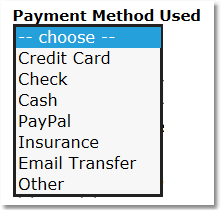The Enter Payment area is used only for accounting purposes. This allows you to record any payment (cash, check, etc.) other than those processed through the merchant account gateway linked to your CounSol.com account.
COMMON ERROR: The Enter Payment button will only adjust the record of payment within the system and DOES NOT process any charges. Only the Process Card Payment button will charge a credit card through the merchant gateway.
Click Here for instructions on charging a credit card within the system.
How to record a payment for account purposes:
Option 1
Enter Payment from Invoice
This is recommended when entering a payment for a specific invoice, when the amount paid is equal to or less than the invoice amount.
If entering an amount greater than an individual invoice, view Option 2.
1. Open the unpaid invoice for the session.
Method 1
A. Click the Sessions icon
B. Select the appropriate sessions list (Today, Week, History, All), then locate the session.
C. Click the Invoice shortcut ($ icon) under the INV column.
Method 2
A. Click the Billing icon.
B. Locate and click on the Invoice # for the appropriate session
Method 3
A. Select the Clients/Patients icon, and then click on the desired client’s name from the Active client list.
B. Click on the Billing tab within the client's chart.
C. Click on the Invoice Number under the Type column.
2. Click the Enter Payment button.
3. Enter the Amount received.
4. Select a Payment Method.
Note: These are for payments that you received outside of the system. If you have a merchant gateway set up in the system you will want to charge the card on file. Click Here for instructions on charging a credit card.

5. Record whether or not this payment is a Client's Insurance Company Payment by selecting Yes or No.
Only select Yes if this payment came directly from the client's insurance company.
6. Select when you want the payment date to post by selecting Now or Choose Date to enter a later date.
7. Select an Email Notification option.
8. Click Save.

Option 2
Enter Payment from Client Billing.
This option is recommended when entering payment received for an amount that is greater than the amount on one specific invoice.
Note: The payment will only count as a credit toward the overall balance, but will not affect the status of an individual invoice until the payment is assigned to a specific invoice.
1. Select the Clients icon, then click on the desired client’s name from the Active clients list.

2. Click on the Billing tab, and then click the Enter Payment button.

3. Enter the Amount received
4. Select the Payment Method.
Note: These are for payments that you received outside of the system. If you have a merchant gateway set up in the system you will want to charge the card on file. Click Here for instructions on charging a credit card.

5. Record whether or not this payment is a Client's Insurance Company Payment by selecting Yes or No.
Only select Yes if this payment is coming directly from the client's insurance company.
6. Select to post the payment by selecting Now, or select Choose Date to post at a later date.
7. Select an Email Notification option.
8. Click Save.

9. On the View Payment page for that payment, you can allocate as much of the payment as you wish to any recorded invoice by selecting an invoice from drop-down list and clicking the Add button.
Tip: If the payment amount added to an invoice covers the entire listed fee, that invoice will automatically be designated on the Billing page as PAID. Partial payments may also be paid towards an invoice, in which case the invoice will automatically be marked with PARTIAL PMT and the remaining balance (BAL) will display.